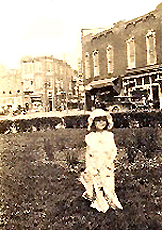My two previous J.J. Page Carnival articles prompted a note from Mrs. Shelby Davis: “My family once lived in the white house at the northwest corner of Watauga and Love Street. We moved there in 1946 when I was nine years old and lived there five years. The Page family house was diagonally behind ours on Highland. A spare lot adjoined our two houses.”
This relocation was shortly after Mr. Page died and about the time Mrs. Page took over the reins of the carnival from her husband during its waning four years. “Our house,” said Shelby, “overlooked three large white wooden storage buildings to the south between Love Street and the railroad tracks that served for years as the five-month winter headquarters for the Page Carnival. The Johnson City Foundry was adjacent to it to the west.”
Shelby said the east building on the Watauga Street side was the largest of the three and had two stories with the upper floor resembling a barn loft. The other two structures were smaller and occupied one floor. All three showed signs of deterioration. “The buildings had likely become a storage area for relics from the carnival’s glory days,” said Shelby. “There were things crammed everywhere in them, including a fairly large quantity of fabric, likely used to make decorations for the carnival. I also recall some old trucks parked around the property.
“Apparently, nothing of value was saved at this site because the Pages never locked the doors and no one was around to guard it. Since my brother and I were nosey,” quipped Shelby, “we often went over to the buildings to see what we could find. The middle building contained a lion locked up in a cage; I remember his large mane. There was also a bear chained and locked to a stake outside the east building along the left side. He wore a path around that stake as he went around and around it trying to escape.
“The west building had some laughing hyenas in cages and monkeys with long chains attached to stakes. Sometimes guests staying at our house would be startled late at night by strange animal sounds. Mom always warned us not to go around the bear because he was not inside a cage. The lion was caged so I guess she did not worry too much about him. These were the only animals I recall being stored there.”
Shelby recalled that a man came daily to feed the animals. She said he threw large chunks of meat into the lion’s cage. She and her brother hardly every saw anyone in the buildings except this person and occasionally some street people taking refuge there. The animals appeared to be reasonably cared for and fed, but she felt sorry for them because they apparently were unwanted remnants of the carnival days. They stayed confined on the property.
Shelby said that some of the more unusual items they found probably came from freak sideshows. There were numerous bizarre specimens contained in glass jars. The young pair once encountered what they believed to be Siamese twins inside of a wooden box. They were joined at their shoulders. Later, she became convinced that they were dummies made to look authentic. It was real enough looking to keep them away from it.

Dorothy Page Samier, Daughter of the Pages at Fountain Square, 1920s
Shelby concluded: “When we moved away from there in 1951, the three buildings were still standing but the animals had been removed by then.” When Shelby drives by that area today, she sees beyond a duck pond and an empty field and visualizes in her mind the electrifying J.J. Page Carnival. (Note: That area has since been cleared for ETSU student housing.)

Comments are closed.